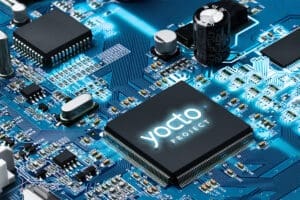Ensuring efficiency and connectivity for your embedded solution means maximizing protocol interoperability. In fact, the ability of software applications to seamlessly communicate and exchange data across various platforms has become a key requirement. In this context, the concept of interoperability has become a critical factor and a cornerstone of modern software development.
This article aims to highlight the importance of interoperability, explaining its benefits and how it fosters a more efficient, cost-effective, and user-centric ecosystem. This article will also showcase how Amotus empowers businesses to break down the barriers between protocols, fostering efficient data exchange and collaboration.
What Is Interoperability in Software Development?
Why Is Interoperability Important for Embedded Solutions?
Interoperability is essential in software development as it enables seamless collaboration, efficient data exchange, cost and time savings, flexibility and integration of legacy systems. By embracing interoperability, businesses can create robust, interconnected software ecosystems that drive efficiency, innovation, and growth.
Organizations encounter numerous challenges when designing products that need to seamlessly integrate into a diversified ecosystem. Training individuals to become proficient in each protocol can be complex and time-consuming. It requires continuous learning, improvement, and even certification exams to validate a product’s proficiency in a specific protocol. Just like students, software applications undergo evaluations, and without certification, they may risk losing significant contracts that demand protocol compliance.
As a polyglot, a software application that can communicate across multiple protocols offers substantial advantages in terms of agility. It can effortlessly interact with various entities without relying on third-party solutions, thus reducing efforts and complexities. For companies, investing in a product that implements all the required protocols proves cost-effective on several levels. It eliminates the need for additional hardware, streamlines maintenance by centralizing it to a single product, and simplifies support by having only one product to work with all others.
Key Protocols and Standards in the Industry
-
- IEC61850: A standard for communication and interoperability in the electrical power industry, enabling seamless communication and control in power substations and smart grid environments.
- IEC60870: Defines protocols for telecontrol and remote supervisory control systems used in the electrical and automation industries, facilitating reliable communication between control centers and remote devices.
- DNP3: A protocol commonly used in the utility industry for SCADA systems, supporting communication between master stations and remote devices in applications like power distribution and water management.
- Modbus: A widely used protocol in industrial automation for communication between devices in a DCS or SCADA environment, allowing for data exchange in industries such as manufacturing and energy.
- BACnet: A protocol designed for building automation and control systems, enabling communication and interoperability between various devices in buildings, such as HVAC systems and lighting controls.
Each protocol operates based on its own paradigm, which must be considered when aiming for standard compliance. Developing scalable software with a polyglot nature requires flexibility and well-design architecture. Such successful design demands in-depth experience with these protocols to understand their unique requirements fully.
Expertise in handling these protocols can expose companies attempting to design interoperable products to difficulties, hindering their ability to provide cost-effective value and expand their protocol offerings.
Conversely, a well-designed architecture acts as a gateway for software protocols, facilitating interactions with existing systems in an ecosystem. It allows for seamless interfacing with different protocols like Modbus, BACnet, and more, and enables integration with the business logic within the product. Moreover, the architecture can interface with a large-scale SCADA system using any appropriate protocol such as IEC61850.
Translating and harmonizing the standards and paradigms of these protocols become a significant challenge in ensuring the value of transported data between different standards. Addressing these challenges and leveraging our expertise in protocol interoperability, our team can deliver software application systems that meet your specific needs and provide optimal value across diverse protocols.
Designing Interoperable Software Architectures
Amotus’ team of experts possesses expertise in scalable and high-demand architectures like cloud computing. This provides us with a strong foundation for working on service-based architecture. By implementing each protocol independently as a service, in a confined manner, we create a solid foundation that seamlessly integrates new protocols into the customers’ systems.
Drawing from our extensive experience in Embedded Software development, we excel in designing resource-efficient solutions using languages such as C/C++ and safety-first solutions using Rust. These capabilities allow us to meet high-performance standards on embedded devices, enabling the delivery of high-demand services on cost-effective hardware.
As polyglot is rare and numerous translators could be expensive, our interoperability expertise can be a cost-saving opportunity. Our team of experts, who have extensive experience working with protocols like IEC61850, IE60870, DNP3, Modbus, BACnet, OCPP seeking to integrate diverse protocols within their systems. By sharing our knowledge, we hope to highlight the importance of interoperability and its valuable benefits, as well as showcase how our capabilities to build architectural designs that enable continuous improvement of our customers’ products.
Furthermore, our expertise in Smart City Intercommunication, Programmable Logical Controllers (PLC), and our deep understanding of industry standards and protocols provide us with a significant advantage in designing valuable data representations for interoperability. We have developed data model representations that facilitate performant translation and scalable flexibility, empowering us to quickly iterate on new protocols.
With our multidisciplinary team, we can design complex architectures with a deep understanding of the expertise required to efficiently manage multi-protocol and connected products. This comprehensive approach mitigates risks, facilitates greater feature penetration in the market, and ultimately reduces costs for our customers’ product development.
Continuous Improvement and Future-Proof Embedded Solutions
Experience is a fundamental aspect of the embedded world. Our team of experts has worked with numerous customers across different iterations of embedded solutions, acquiring valuable expertise and learning from past design mistakes. We have built our strength on these experiences, continuously improving our customers’ current and future products.
We recognize the importance of future-proofing our customers’ products to ensure their adaptability to evolving interfaces, protocols, and technologies. A product that can thrive for decades is one that can seamlessly adapt to changes. To achieve this, we have embarked on proof-of-concept projects and supported multiple major software releases, enabling us to consistently meet evolving product requirements.
For instance, we have designed architectures that initially address our customers’ needs with basic interoperability for different protocols. However, as the project progresses, we proactively reassess and refine our design choices. We may rewrite sections of the software, redesign data model representations, and incorporate new technologies to meet more complex demands. These changes not only enhance the software’s capabilities but also improve its maintainability and overall future proofing within the product.
We recognize the criticality of beginning with a proof of concept to validate the feasibility of a solution. However, we also understand that in certain cases, it may be necessary to rebuild a new generation of the solution once the project aligns with the specific needs of the customer. This approach enables us to effectively address any challenges or issues encountered during the development process, ensuring the delivery of a robust and high-quality outcome. By being adaptable and responsive to our customers’ evolving requirements, we can ensure that the final solution meets their expectations and sets the foundation for long-term success.
In Conclusion
As the world continues to embrace interconnectedness, prioritizing interoperability becomes paramount for businesses and developers seeking to make a lasting impact. With interoperability as the guiding principle, the possibilities within software development are limitless, paving the way for a brighter, more interconnected future.
Our team of experts brings a wealth of experience and technical capabilities to the field of embedded solutions and protocol interoperability. By leveraging our expertise in protocols, we enable seamless communication and interoperability between diverse devices and systems.
Whether you are starting from scratch or looking to enhance your existing embedded solution, designing and implementing an efficient, interoperable, and future-proof system is essential. By partnering with Amotus, you can benefit from our multidisciplinary expertise, cost-effective solutions, and collaborative approach that focuses on delivering optimal value to your organization.







